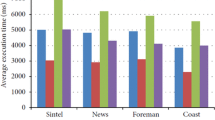Abstract
A testbed has been constructed to evaluate node architectures that support multimedia applications and services across a wireless network. Using this testbed, a low bitrate subband video compression algorithm has been prototyped in a field programmable gate array (FPGA) and evaluated for video networking across bandwidth-limited RF channels. A radio interface has been prototyped in an FPGA and a common applications programming interface (API) has been developed to allow experimentation with multiple radios. This testbed has been used to evaluate node performance under two different wireless applications: 1) simultaneous video and data networking (VTALK) and 2) TCP/IP utilities such as FTP and telnet. Based on this evaluation, the design of a battery-operated high throughput wireless multimedia node is presented.
Similar content being viewed by others
References
P. Agrawal et al., “A testbed for mobile networked computing,”Proceedings IEEE Communication Conference, Seattle, WA, June 1995.
B. Barringe et al., “Infopad: A system design for portable multimedia access,” inWireless 1994, Calgary, Canada July 1994.
J.K. Holmes, “Coherent spread spectrum systems,” Wiley, New York, 1982.
Pickholtz et al., “Spread spectrum for mobile communications,”IEEE Trans. on Vehicular Technology Vol. 40, No. 2, pp. 313–321, Dec. 1992.
M.K. Simon et al.,Spread Spectrum Communications, Vol. 3, pp. 3–15, 1985.
C. Chien et al., “A 12.7 Mchips/sec all-digital BPSK directsequence spread spectrum IF transceiver,”IEEE Journal of Solid-State Circuits, Vol 29, No. 12, Dec. 1994.
P.T. Yang, “Design and implementation of a spread-spectrum radio,” Ph.D. Dissertation, University of California at Los Angeles, 1993.
A. Salmasi and K. Gilhousen, “On the system design aspects of code division multiple access applied to digital cellular and personal communications networks,”Proc. of the IEEE Veh. Tech. Conf., pp. 57–62, May 1991.
B. Chung et al., “Performance analysis of an all-digital BPSK direct-sequence spread-spectrum IF receiver architecture,”IEEE, JSAC, Vol. 11, pp. 1096–1107, Sept. 1993.
A. Chandrakasan et al., “A low power chipset for portable multimedia applications,”IEEE International Solid-State Circuits Conference, San Francisco, CA, Feb. 1994.
M. Harrand et al., “A single chip videophone encoder/decoder,”IEEE International Solid-State Circuits Conference, San Francisco, CA, Feb. 1995.
B. Belzer et al., “Adaptive video coding for mobile wireless networks,”IEEE International Conference on Image Processing, Austin, TX, Nov. 1994.
E. Tsern et al., “Video compression for portable communication using pyramid vector quantization of subband coefficients,”IEEE Workshop on VLSI Signal Processing, 1993.
Author information
Authors and Affiliations
Rights and permissions
About this article
Cite this article
Chien, C., Nazareth, S., Lettieri, P. et al. An integrated testbed for wireless multimedia computing. J VLSI Sign Process Syst Sign Image Video Technol 13, 105–124 (1996). https://doi.org/10.1007/BF01130401
Received:
Revised:
Published:
Issue Date:
DOI: https://doi.org/10.1007/BF01130401




